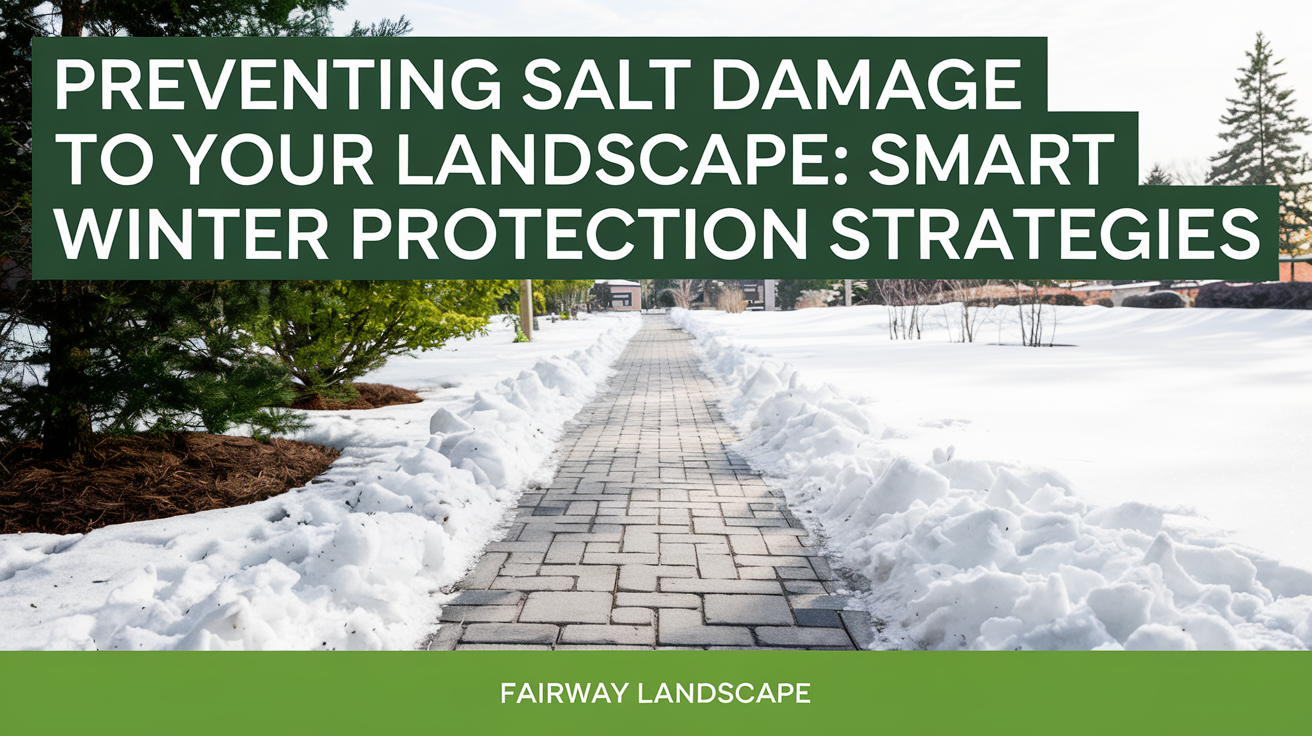The recent ice storm that swept through Harford and Cecil Counties left roads and walkways treacherously slick, prompting heavy applications of road salt and deicers on highways, residential streets, and private properties. While these products are essential for winter safety, they pose significant threats to your valuable landscape plants, soil health, and hardscape elements. The environmental impact of winter salt use extends far beyond the immediate application areas, with splash, spray, and runoff carrying damaging compounds throughout your property. Understanding these risks and implementing protective measures can prevent costly damage to your landscape investment.

Understanding How Deicing Salt Damages Landscapes
Direct contact injury occurs when salt spray contacts plant tissues. Evergreens along roadways often show characteristic browning on the road-facing side where salt spray has desiccated foliage. This direct contact damage is particularly severe on windy days when salt spray travels further from application areas. Our landscape salt protection strategies include physical barriers that intercept this spray before it reaches vulnerable plants.
Soil absorption creates long-term plant stress. As salt-laden snow melts, dissolved salts infiltrate soil around plants, disrupting nutrient uptake and damaging beneficial soil microorganisms. This soil contamination can persist for months, affecting plant health long after winter ends. Our professional winter landscape care includes soil remediation techniques that mitigate this accumulated damage.
Hardscape deterioration accelerates with salt exposure. Concrete surfaces, natural stone, and masonry elements all suffer when repeatedly exposed to deicing compounds. Surface scaling, spalling, and accelerated freeze-thaw damage occur as salt solutions penetrate porous materials. Our comprehensive protection approach addresses these hardscape vulnerabilities with appropriate sealants and alternative deicing strategies.
Identifying Salt-Vulnerable Areas in Your Landscape
Splash zones extend further than most homeowners realize. Salt damage isn’t limited to plants directly adjacent to treated surfaces. Vehicle traffic creates splash patterns that can carry salt spray 50 feet or more from roadways, while snowplows throw salt-laden snow even further. Our professional assessment identifies these extended risk zones that might otherwise be overlooked.
Drainage patterns determine where salt accumulates. Melting snow and ice carry dissolved salts to low areas where concentration increases as water evaporates. These accumulation zones often experience the most severe soil contamination and plant damage. Our winter salt damage prevention strategies include drainage modifications that direct contaminated runoff away from vulnerable landscape areas.
Microclimates influence salt damage severity. Areas with higher sun exposure experience more rapid freeze-thaw cycles, often leading to increased deicer application. Similarly, wind patterns affect how salt spray travels throughout your property. Our site-specific protection plans account for these microclimate variations rather than applying one-size-fits-all solutions.
Plant Selection for Salt-Tolerant Landscapes
Native species often demonstrate superior salt tolerance. Plants that naturally occur in coastal areas or along roadways have evolved mechanisms to cope with salt exposure. Our professional plant palette includes native selections like bayberry, eastern red cedar, and switchgrass that maintain appearance and health despite moderate salt exposure.
Strategic placement reduces salt exposure risk. Thoughtful landscape design positions salt-sensitive plants away from high-risk areas while using more tolerant species as protective buffers. Our redesign recommendations for salt-damaged landscapes incorporate these strategic placement principles to prevent recurring problems.
Replacement options for salt-damaged plants include numerous attractive alternatives. When existing plants have suffered significant salt injury, our professional guidance helps select appropriate replacements based on your specific site conditions and aesthetic preferences. This targeted approach replaces vulnerable species with similarly attractive but more resilient options.
Physical Protection Strategies for Existing Landscapes
Temporary barriers provide effective protection during winter months. Burlap screens, snow fencing, and commercial protection fabrics can intercept salt spray before it reaches vulnerable plants. Our professional installation ensures these barriers are properly positioned and secured to withstand winter conditions while providing maximum protection.
Raised planting areas reduce salt exposure from runoff. Elevating planting beds above grade level helps prevent salt-contaminated runoff from reaching root zones. Our landscape modification services include creating these protective grade changes that integrate seamlessly with your existing landscape design.
Mulch application provides buffer protection for soil and roots. Proper mulching creates a physical barrier that absorbs and dilutes salt before it reaches sensitive root zones. Our professional winter landscape care includes appropriate mulch application that balances protection needs with proper horticultural practices.
Alternative Deicing Approaches for Landscape Safety
Calcium magnesium acetate (CMA) offers reduced plant damage potential. This alternative deicer performs effectively at moderate temperatures while causing significantly less harm to plants and soil than traditional rock salt. Our winter protection programs include guidance on appropriate deicer selection for different landscape areas based on specific requirements and vulnerabilities.
Sand and non-clumping cat litter provide traction without chemical damage. For areas where traction rather than ice melting is the primary concern, these non-damaging alternatives offer practical solutions. Our comprehensive winter protection strategies identify where these alternatives can effectively replace more damaging chemical deicers.
Heated walkway systems eliminate deicer needs entirely. For high-value landscape areas or properties where salt damage has been particularly problematic, snow-melting systems provide the ultimate protection. Our design services include integration of these systems into new construction or renovation projects where appropriate.
Remediation Techniques for Salt-Damaged Landscapes
Soil flushing dilutes accumulated salt concentrations. Early spring irrigation that thoroughly saturates affected soil areas can leach salts below root zones before active growth begins. Our professional remediation services include calibrated flushing that removes harmful salts without creating drainage problems or erosion.
Gypsum application helps displace sodium ions from soil particles. This calcium-based amendment counteracts some of salt’s most damaging effects on soil structure and plant health. Our soil restoration programs include appropriate gypsum application based on soil testing and specific site conditions.
Organic matter incorporation accelerates soil recovery. Adding compost and other organic amendments helps restore microbial activity and soil structure damaged by salt exposure. Our comprehensive remediation approach includes these vital organic inputs that rebuild soil health from the ground up.
Hardscape Protection from Salt Damage
Sealant application provides essential protection for porous materials. Concrete, natural stone, and masonry surfaces benefit from appropriate sealants that prevent salt solution penetration. Our professional application services include selection of appropriate products for different materials and exposure conditions.
Drainage improvements prevent salt concentration in vulnerable areas. Proper slope and drainage channel design directs salt-laden runoff away from sensitive hardscape elements. Our comprehensive winter protection includes assessment and modification of drainage patterns to minimize salt damage risk.
Sacrificial mats protect high-value entrance areas. Removable mats placed at entryways capture salt before it’s tracked onto valuable interior floors or exterior hardscapes. Our winter protection guidance includes recommendations for appropriate mat selection and placement to maximize protection.
Professional Monitoring and Intervention
Regular inspection throughout winter allows early intervention. Our professional winter landscape care includes periodic property assessments during deicing season, identifying developing problems before they cause significant damage. This proactive approach prevents minor salt exposure from escalating to serious landscape injury.
Targeted irrigation dilutes salt concentrations during winter thaws. During periods of above-freezing temperatures, strategic irrigation can help flush accumulated salts from sensitive areas. Our monitoring services include these intervention opportunities that minimize damage during the winter season.
Documentation of salt damage patterns informs future protection strategies. By tracking specific damage locations and severity, our professionals develop increasingly refined protection plans for subsequent winters. This continuous improvement approach progressively reduces salt damage risk throughout your landscape.
Partner with Fairway Landscape for Complete Winter Protection
At Fairway Landscape, we offer comprehensive winter protection services throughout Harford and Cecil Counties. Our experienced professionals understand the unique challenges of our regional climate and implement proven strategies to minimize salt damage to your valuable landscape. From preventative measures before winter begins to remediation services in spring, our complete service packages ensure your landscape remains beautiful and healthy despite winter maintenance challenges.
Contact us today to schedule your professional winter landscape assessment. Our experts will evaluate your property’s specific vulnerabilities and develop a customized protection plan that addresses your landscape’s unique needs. Don’t let deicing salt damage your valuable plants and hardscape elements—partner with Fairway Landscape for professional protection that preserves your landscape investment.

